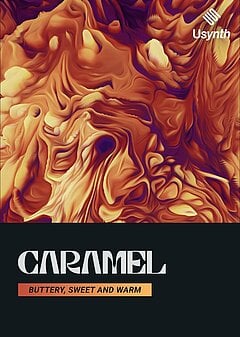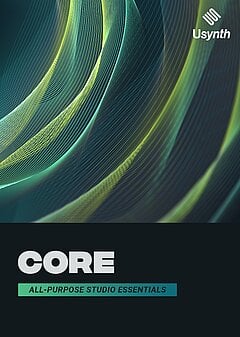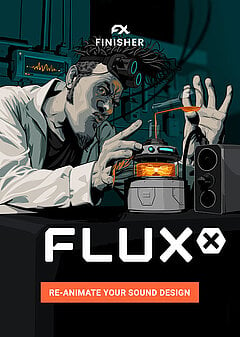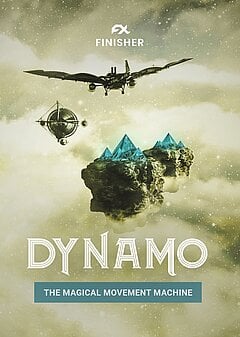Sound Design with STRIIIINGS and Usynth Caramel
Creating pads, atmospheres and ambient beds for fuller and more unique arrangements in electronic music
FEBRUARY 20TH, 2022
By the end of this article you will have an idea of how to sound design with UJAM's STRIIIINGS and the new Usynth CARAMEL.
- Using string textures in electronic music
- Drop chords with strings
- Principles of layering
- Effects with strings (DYNAMO, volume chopping)
- Wrapping up
1. Using string textures in electronic music
Before designing chords, textures and other effects with these two plugins, you’ll want to first understand the quality that legato or sustained strings lend to any song. Because a string ensemble contains as many as 60 musicians all playing with slight timing and style differences, the result is a rich texture that’s nearly impossible to replicate through modern synthesis technology. Take STRIIIINGS’ SUS Sustain Full preset — play a single note and you get a gradual crescendo and decrescendo that lasts for quite some time. Combine this with a pad from Usynth Caramel using the Alien Horizon Synthesizer setting, for example, and you immediately have a lush chord bed to fill any dead space in the slower sections that feel like they need something more.
Slow strings also provide an irregular airiness that you can’t quite achieve with a sound as rigid as a supersaw. The most effective (simple) way to mimic strings with a synth is to create a supersaw with many voices with a low pass filter — combine that with actual strings, and you’ll achieve a hybrid sound that is often even more powerful than strings alone in EDM! With the same SUS Sustain Full setting in STRIIIINGS, try using the Cotton Wool Pad Synthesizer setting in Caramel; together, the two create complex chords and textures to make glossier, warmer ambient pads. Lower the Dark/Bright and Spectral Sweep settings and you’ll deepen this effect even further.
Of course, this assumes you’re using ambient pads to create ambient and meditative sounds, perhaps during intros and verses (or the main body of an ambient song). But that’s not necessarily the case ... nor is it the only thing strings excel at in electronic music. You can see this in action by looking at drops.
2. Drop chords with strings
Drops are typically the most intense part of the song, and often involve dialing up the distortion and stacking progressively larger supersaws. There are other options, though, and strings provide a great opportunity to add greater depth and the complexity you only find in acoustic instruments.
There are infinite ways to orchestrate chords in a drop, but one highly effective way is most common with future bass (though it can be used in many other genres): take a single chord and repeat it every 16th note except for right on the kick and snare hits. This is as simple as repeating the notes of the chord, but you can also use volume and filter shaping to “carve out” each note in your chosen synth. Usynth Carameland Finisher DYNAMO are a perfect pair for this: creating pads with Caramel and using DYNAMO for tremolo, filter and other effects. All you have to do is hold down one chord at a time and let this simple chain do the rest.
Layer this with STRIIIINGS, and you get magic. For example, try out the OST Be Alert preset, click on “Timing” in the bottom right hand corner and change the Speed to 2x. Play around with other presets by all means, but this one-two combo will provide you with rich, punchy drop chords that immediately sound above and beyond most of the EDM drops you hear! Make rhythmic adjustments as desired, EQ, compress, etc., with the goal of getting the synth and string attacks synced up exactly. This will give the illusion that they’re one hybrid instrument, which listeners will latch onto and think, “what is that?” (in a good way!).
This is a perfect segue into a deeper look at layering synths and strings together...
3. Principles of layering
Part of the reason this combo is so powerful is that for most people, subconsciously, strings are synonymous with “orchestra” — and even for people who don’t listen to orchestral music, there’s often an association between orchestral arrangements and “epic” music. By layering strings with your pads, plucks and more, you can lend this epic quality to any electronic music you create. If you mimic the frequency balance of synths within the strings, line up the note attacks, and play with note lengths, releases, and any other settings you like, you can disguise the strings behind the synth chords so it all sounds like a single instrument ... which is the ultimate goal with most layering.
It’s worth noting as well that the strings don’t need to sound realistic when layered with synths, so you can apply any effects you like, chop them up, etc. Be ruthless when blending these different sounds together, and the result won’t sound like an EDM drop with strings — it will sound like an extra powerful drop, and most listeners won’t know exactly why.
After you add layers of both Caramel and STRIIIINGS, decide which layer you want to be more dominant in the mix. While this might sound trivial, this makes the difference between a beefier string sound (strings louder) and a more organic synth pad (synth louder). Depending on the style and genre you’re going for, this decision will change based on the context. It’s possible for the two layers to sound perfectly even and blended, but this often requires tons of compression, EQ, etc. — it’s far easier to choose which one you want to shine through and use the other as a support layer.
4. Effects with strings (DYNAMO, volume chopping)
You can also use strings in a less literal, “incorrect” way by adding different effects in post. Try adding delays, volume chops, filter sweeps, granulation, glitchiness and other effects — essentially, anything that sounds deliberately unnatural to add to the character of the song. Finishers DYNAMO and FLUXX are both excellent tools for this; cycle through presets on both, and you’ll quickly discover string sounds you never imagined were possible!
From there, use your ear to determine what will sound unique while improving your song. It’s easy to get absorbed by the “coolness” factor you’ve created, but for the purposes of creating music, understanding the musical context you’re working with is vital to creating something that works (of course, if you’re simply in sound design mode and are working outside the context of a song, you can happily ignore this advice).
Usynth (and by extension, Caramel) has its own built-in Finisher section, consisting of everything from single effects with fine controls to 4-part multi-effects that offer dramatic control over the synth patches you create. If you want the strings and pads to function separately with their own rhythms and timbre, use Caramel’s Finisher and add one onto STRIIIINGS or use the pared-down Finisher embedded in the UI.
However, if you want both instrument tracks to work in concert and sound like one instrument, deactivate the native Finisher in each plugin. Instead, group both tracks together and place a Finisher plugin like DYNAMO or FLUXX across both of them together. Processing multiple instrument or audio tracks together instantly makes them sound like they belong together, especially the more extreme the processing gets. This is a valuable principle to keep in mind for every song you create!
Wrapping up
You’ll discover tons of creative possibilities in the combination of Usynth Caramelpads and STRIIIINGS, whether you’re aiming for legato and slow or punchy and staccato passages. Both tools will do a very effective job on their own, but the real magic lies in combining them together — how you layer them and the processing options you choose can manipulate the overall feel of your music, and this blend of acoustic and synthetic elements is a valuable tool for any producer’s arsenal.
You also have the option to let go of the way conventional strings are used, instead opting to chop them up with effects like UJAM’s Finishers. This is a fantastic way to add unpredictability to your backgrounds, chords and textures alike, and it involves virtually no manual work — simply audition a few Finisher presets until you come upon something new and fresh, then work it into your music at the optimal point!
This combination of pads and strings is just one example of the many ways you can add a bit more than other producers are willing to: more creativity, more variety, and more influences that extend the definition of any one genre. As you become more comfortable with this, it will become easier to continue creating new combinations and setting your unique style apart ... and ultimately, that’s how you create something truly great.
About the Author
Harry Lodes is a copywriter, marketing consultant and content writer for audio and ecommerce brands. He lives in the Philadelphia area, releasing Eastern/Western hybrid EDM under the artist name KAIRI hearkening back to his roots in Berklee College of Music.
Stay up to date
Sign up and we’ll send you an e-mail with product news and helpful stuff every now and then. You may unsubscribe at any time.
Defy Limits
We develop software solutions that enable people to create, consume and interact with music.






